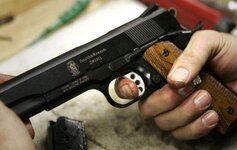- Messages
- 17,471
- Reactions
- 36,484
Bet you knew they had one. I didn't.
How's that working ?
Maryland Scraps 'Gun Fingerprint' Database as Complete Failure: After 15 years, not a single "gun violence" case was solved.
"Millions of dollars later, Maryland has officially decided that its 15-year effort to store and catalog the "fingerprints" of thousands of handguns was a failure. Since 2000, the state required that gun manufacturers fire every handgun to be sold here and send the spent bullet casing to authorities. The idea was to build a database of "ballistic fingerprints" to help solve future crimes. But the system — plagued by technological problems — never solved a single case. Now the hundreds of thousands of accumulated casings could be sold for scrap."
How's that working ?
Maryland Scraps 'Gun Fingerprint' Database as Complete Failure: After 15 years, not a single "gun violence" case was solved.
"Millions of dollars later, Maryland has officially decided that its 15-year effort to store and catalog the "fingerprints" of thousands of handguns was a failure. Since 2000, the state required that gun manufacturers fire every handgun to be sold here and send the spent bullet casing to authorities. The idea was to build a database of "ballistic fingerprints" to help solve future crimes. But the system — plagued by technological problems — never solved a single case. Now the hundreds of thousands of accumulated casings could be sold for scrap."












